Introduction
When one explores the complex relationship between man and other animals, “fame” is a fascinating issue, especially in our anthropocentric and celebrity-driven cultures. On the one hand, we deny most individual rights to, in the words of Jacques Derrida, “what we are still daring to name in general, but in the singular, the animal.” On the other hand, we elevate certain outstanding animals to the rank of “heroes” or “idols” - in the form of anthropomorphic divinities, legends, or media personalities. These celebrities form an aristocracy, above the place of “ordinary animals.”
All human societies have reserved a mythical or allegorical place for these extra-ordinary animals, “fictitious” or “real,” from the most ancient myths of origin to the most recent scientific discoveries. Some animals become famous by their own merits or because of their own crimes, like the dolphins that save sailors and surfers in California or the man-eating lions of Tsavo, now on display in a museum in Chicago. Most of the time, however, “famous animals” (the title of a pioneering book by historian Michel Pastoureau) serve human purposes: they make us laugh, dream, hope, fear, or buy things. Actual, imaginary and symbolic animals have often co-existed on the same “plane of truth.” We still use animal emblems and mascots in order to foster unity, and we still turn to animal metaphors to describe our own political and economic jungle.
This exhibition offers an opportunity to reflect on the process of cultural selection and adoption of animal individuals turned into “legends.” Some have been handed down through the centuries, transmitted first orally and then in writing. Today, other animals enjoy their “fifteen minutes of fame” online, only to be quickly forgotten. In either case, biology, anthropo-zoology, cultural history, literature and theory together teach us much about our humanimality.
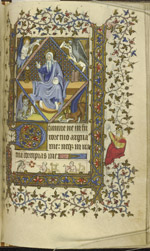 |
The Animals of the Evangelists. Book of Hours. France, circa 1450. [zoom] | Additional images:  
In the Christian world, the symbols of the four Evangelists are often shown with, or in place of, the four disciples of Jesus credited with the creation of the four Gospels in the New Testament. In classical iconology, they surround the Christ or God in Majesty, thus reflecting the Vision in Revelations. This motif can still be seen on the portals and apses of many cathedrals, as well as in books of private devotion such as this precious book of hours, which includes Biblical figures represented by animals. Here they surround God the Father. The winged man (Matthew) represents the human nature of Jesus. The eagle (John) takes a “higher view of things” and represents the celestial nature of Jesus. The winged lion (Mark) represents him as king, and also refers to his resurrection, because “the king of animals” was believed to sleep with his eyes open, a comparison with Jesus in the tomb, whose body slept but whose divine nature did not. Finally, the winged ox (Luke) is a figure of sacrifice, service and strength, virtues that Christians must adopt in imitation of Jesus Christ. |
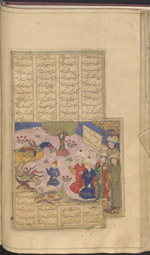 |
The Simurgh. Šāhnāmeh. Persia, 17th century. [zoom] | Additional images:  
Šāhnāmeh (Persian: شاهنامه), “The Book of Kings,” was written by the poet Ferdowsi around 1000 CE. This is the national epic of the Persian speaking world. It recounts the mythical and historical past of Greater Iran, beginning with the creation of the world and the introduction of the arts of civilization up until the Islamic conquest of Iran in the 7th century. The present miniature illustrates the reunion of Sam (the figure with the moustache and the largest turban) and his abandoned son Zal. When Zal was born with white hair, Sam concluded that he was the spawn of a demon, so he abandoned him on the top of a mountain. The Simurgh, a fantastic bird, fostered the boy and taught him wisdom. In this scene, the bird is reluctantly giving the boy up to his father, but before doing so, gives Zal one of his feathers and instructs him to burn the feather in the event he is in trouble: the Simurgh will come to his aid. |
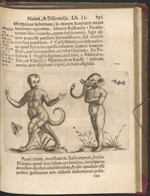 |
The “Elephant-Man.” Fortunio Liceti. De monstrorum natura, causis, et differentiis libri duo (Two Books on the Nature, Causes, and Differences of Monsters). Pavia: Crivellari, 1616. [zoom] | Additional images: 
In 1616 Fortunio Liceti, then a professor of medicine and philosophy at the University of Pisa, published this book, which marked the beginning of studies into malformations of the embryo. He described various “monsters” and looked for reasons to explain their deformities: rather than invoking the glory or wrath of God, Liceti proposed that degeneration of semen was the main cause for the embryo’s failure to develop properly. Other authors attributed the birth of “monsters” to a frightening shock experienced by the pregnant mother. The superstition endured for centuries: Joseph Merrick (1862-1890), the “Elephant Man,” still believed that his terrible disease had been caused by a circus elephant knocking his mother down during her pregnancy. The story inspired the opening scene of David Lynch’s Elephant Man (1984). |
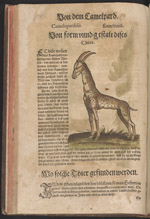 |
The Cameleopard. Conrad Gessner. Thierbuch: das ist, Aussführliche Beschreibung und lebendige ja eigentliche Contrafactur und Abmahlung aller vierfüssigen Thieren so auf der Erden und in Wassern wohnen [1551]. Heidelberg, 1606. [zoom] | Additional images: 
Increasing curiosity about the world in 16th-century Europe prompted a new fascination with exotic creatures like giraffes, which were thought to be a combination of a camel and a leopard (cameleopardis.) While Florentines were amazed by a giraffe offered to Lorenzo de’ Medici in 1486, most Europeans never had an opportunity to actually see one, and consequently had to rely on the same dubious images. Gessner included several “giraffes” in his book on quadrupeds. The one on the left comes directly from a 1486 woodcut, allegedly based upon a giraffe seen in Cairo. The image on the right, supposedly “more accurate,” is in fact even more fanciful, with the keeper less than a quarter the size of the blue, dinosaur-like animal! The text reads: “This camel-horse sent to Germany in 1559 must be called Giraff or Kamelpard [sic].” According to Charles D. Cuttler, the second giraffe brought to Europe after 1487 was the one offered by the Pasha of Egypt to King Charles X of France in 1826. This charismatic mammal inspired a real girafomania. |
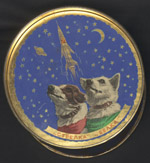 |
The First Dogs in Space. Candy-Box for Christmas. Soviet Union, 1961. [zoom] Mixed-breed female dogs Belka (Белка, “Squirrel”) and Strelka (Стрелка, “Arrow”) were among the first living creatures to spend an entire day in space, on board Sputnik 5, on August 19, 1960 - before safely returning to Earth. They were accompanied by one rabbit, forty-two mice, two rats, flies, and a number of plants and fungi. All passengers survived, but only the dogs became folk heroes. Like Lenin, Belka and Strelka were embalmed after their death. They are still on display at the Museum of Cosmonautics in Moscow. |
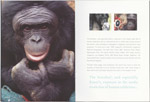 |
Kanzi, the Talking Bonobo. Des Moines, Iowa, 2010. [zoom] Courtesy of the Great Ape Trust, Des Moines, Iowa. Kanzi (b. 1980) is a male bonobo who has been featured in several studies on great ape language. With the help of Dr. Sue Savage-Rumbaugh, Kanzi has exhibited amazing linguistic aptitude via the use of a board containing 384 graphic symbols. With his sister Panbanisha and his son Teco (b. 2010), Kanzi has achieved worldwide celebrity in recent years, as shown by this brochure published by the Great Ape Trust, a unique sanctuary opened to primates in 2004. As with humans, fame can bring both advantages and disadvantages. While media exposure and public curiosity about the bonobos are an advantage in terms of funding and public access to knowledge, all the attention may become disruptive to the highly controlled environment necessary for research. |
 |
Diogenes, the Dog. Plaster Sculpture, Late 19th Century [Original at the Villa Albani, Rome]. [zoom] On loan, courtesy of the Cornell Plaster Cast Collection. Ancient Greeks knew the extravagant philosopher Diogenes of Sinope (400-323 BC) by many names, including “Diogenes who is like a dog,” but we don’t know for certain why.Many anecdotes about Diogenes refer to his “cynical” (etymologically, “dog-like”) behavior. He is said to have lived naked, in a huge clay jar on the streets of Athens, surrounded by stray dogs. Apparently, he thought that humans would do well to imitate them, because dogs live without shame or resentment, and achieve the kind of self-sufficiency (αύτάρκεια) that is valued by philosophers. When Diogenes died, the city of Corinth erected a marble statue of a dog over his grave, and it became customary to portray him with his “doggy double” at his side. The present small-scale copy, made after an undated Roman original, was part of a collection of more than 500 plaster casts of ancient Greek, Roman, Egyptian, and medieval pieces compiled in the 1890s with funds from Cornell trustee Henry Sage. Today, most of what remains of the collection is housed in a warehouse near the Ithaca airport. |
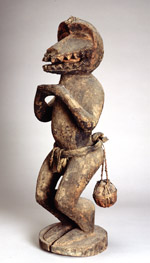 |
Gbekre. Sculpture. Côte d’Ivoire, Africa, 20th century. [zoom] On loan, courtesy of the Herbert F. Johnson Museum of Art. Placed as guardian at the gates of many villages on the central Ivory Coast, this baboon figure is often considered the protector of the living and the patron of farmers among the Baule people. According to a very old mythology, Gbekre is the son of Nyamye, the god of heaven, whose symbol is the ram. Traditionally, Gbekre receives offerings to ensure the protection and fertility of the farmers’ crops. For that reason, Gbekre is portrayed with open hands, or holding small cups for sacrificial offerings. Renowned for its elegance, Baule art is stylistically diverse. Carved in natural unstained wood with minimal details and projecting jaws, the gbekre figures are in contrast to the smooth and shiny surfaces and intricate stylization of many sculptures. |